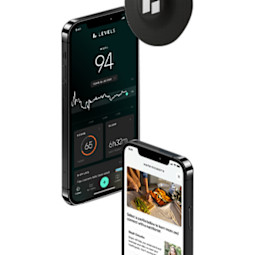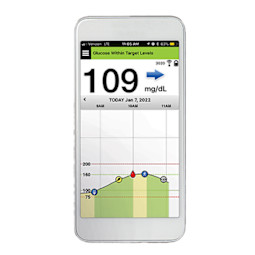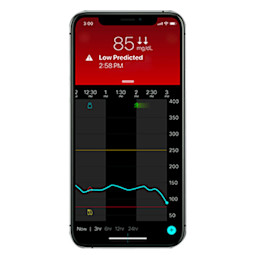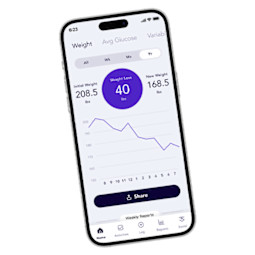6 Best Continuous Glucose Monitors To Keep Your Blood Sugar In Check
Diabetes and blood-sugar-related health concerns affect 1 in 10 Americans—but hourly
but the best continuous glucose monitors (CGMs) have transformed how easily people can monitor their blood sugar. Of course, that's just the tip of the iceberg.
Continuous glucose monitors play a critical role in maintaining healthy blood sugar levels1. They provide real-time monitoring of glucose levels, which supports improved management and healthier outcomes.
Read on for expert insight on choosing the best CGM and how to use these devices to improve your health.
The best continuous blood glucose monitors:
What is blood glucose?
Blood glucose, commonly known as blood sugar, is a key health indicator. It acts as the primary fuel source for our cells, especially those in the brain.
Derived mainly from the foods we consume, particularly carbohydrates such as grains, fruits, vegetables, and sugars, glucose is broken down and released into our bloodstream. It is also created by our liver in a process called gluconeogenesis.
The balance of glucose in your blood is controlled by an intricate system involving several hormones, chiefly insulin and glucagon, both produced by the pancreas. After eating, our blood glucose levels increase, signaling the pancreas to produce insulin. This insulin then functions to facilitate glucose absorption by our cells, where it is used for energy or stored for later use.
When blood glucose levels diminish, the pancreas releases glucagon, which prompts the liberation of stored glucose back into the bloodstream.
Persistent high blood glucose levels, a state known as hyperglycemia, can lead to health complications such as diabetes, heart disease, kidney disease, among others. Conversely, hypoglycemia, or exceedingly low blood glucose levels, can result in a slew of symptoms including weakness, confusion, and in severe cases, loss of consciousness.
Monitoring blood glucose levels is especially important for individuals with diabetes. This is where CGMs are instrumental, as they provide real-time data on glucose levels, aiding individuals in better managing their health.
What is a continuous blood glucose monitor?
A continuous glucose monitor (CGM) is a device that provides real-time measurements of blood glucose levels throughout the day and night. This advanced tool helps people, particularly those with diabetes, actively manage their blood sugar levels.
A typical CGM system consists of three parts:
- A small, disposable sensor that is inserted under the skin, typically on the belly or arm. This sensor measures glucose levels in the body's interstitial fluid, which is the fluid between the cells.
- A transmitter that attaches to the sensor. This transmitter sends the data collected by the sensor wirelessly to a display device.
- A display device, which can be a dedicated receiver or a compatible smartphone or smartwatch. This device shows the current glucose level, as well as historical data and trend information. Some models can also send alerts if glucose levels are too high or too low.
The primary advantage of a CGM is that it provides a more comprehensive view of blood glucose levels compared to traditional blood glucose testing, which only provides a single point-in-time measurement. A CGM displays glucose direction and rate of change, alerting the user to highs, lows, and rapid changes.
When used mindfully, CGMs offer insights into how diet, physical activity, medication, and illness impact blood sugar levels. This information is extremely beneficial in making decisions about food choices, exercise routines, and medication dosage.
Just remember, while CGMs are a significant advancement in blood sugar monitoring, they do not eliminate the need for regular blood glucose testing. Always consult with a health care provider to determine the best management plan for your needs.
Our picks for the best continuous blood glucose monitors:
Pros:
- Personalized diet and lifestyle recommendations based on your unique data
- Integrates easily with other health apps
Cons:
- Not typically covered by insurance plans
Collection method:
Self-inserted sensor applied to back upper armTest type:
Interstitial fluidTests offered:
Continuous Glucose Monitor (CGM)Metabolic scoringBiomarkers checked:
GlucoseResult time:
Real-timeInsurance coverage:
Typically not covered by insuranceLevels uses continuous glucose monitoring technology to offer deep, personalized insight into how your body responds to different foods and activities. It goes beyond traditional glucose monitors by providing a metabolic score, which helps you understand the overall impact of your diet and lifestyle on your health.
These comprehensive, individualized health metrics and insights empower users to understand the direct effects of their dietary choices and lifestyle habits, and to take control of their health proactively.
What's more, Levels integrates seamlessly with other health apps, so you can consolidate your health data in one place.
Best for Newly Diagnosed with Diabetes: FreeStyle Libre 3

Pros:
- No finger prick needed
- Useful for frequent testing
- Uses an iPhone or Android to scan your sensor
Cons:
- May provide inconsistent readings
- Could cause skin irritation around the sensor
Collection method:
Interstitial Fluid, small sensor self-applied to back of upper armTest type:
Continuous Glucose Monitoring (CGM)Tests offered:
GlucoseBiomarkers checked:
Glucose levelsResult time:
ImmediateInsurance coverage:
Varies by provider, but claim that most covered individuals will pay less than $40 a month.This device is particularly great for those who require multiple daily checks of their glucose levels. Unlike traditional devices, the Libre uses interstitial fluid for glucose measurement, eliminating the need for finger pricks.
The user-friendly design involves a sensor worn on the upper arm, with an accompanying monitor that can be waved over the sensor to gather readings (or you can use your smart phone).
People love the FreeStyle Libre for how convenient and easy to use it is. A few complain that the sensor causes irritation on sensitive skin.
Pros:
- Automatically transmits data every 5 minutes
- Seamlessly integrates with insulin pumps
Cons:
- Sensor needs to be changed every 10 days
Collection method:
Wearable self-inserted sensor on back of upper armTest type:
Continuous Glucose Monitoring (CGM)Tests offered:
GlucoseBiomarkers checked:
Glucose levelsResult time:
Every 5 minutesInsurance coverage:
Varies by provider, but most people with type 1 diabetes on commercial health insurance are covered.This CGM stands out for its accuracy and consistency. The sensor is worn on the abdomen and transmits data every five minutes. Results can be viewed in the corresponding app.
A notable advantage of the Dexcom G7 is its compatibility with insulin pumps, making it a comprehensive solution for diabetes management.
One potential downside is that the sensor needs to be changed every ten days, but most users still recommend this device for its accuracy and convenience.
Pros:
- Long-lasting sensor only needs to be replaced every 6 months
- Provides readings automatically every five minutes
- Comes with a discreet vibration alarm feature for blood glucose level alerts
Cons:
- Sensor replacements require a doctor’s appointment
- Sensor may give inaccurate alerts when exposed to direct sunlight
Collection method:
Subcutaneous sensor on the upper armTest type:
Continuous Glucose Monitoring (CGM)Tests offered:
Blood glucoseBiomarkers checked:
GlucoseResult time:
Instant, with updates every 5 minutesInsurance coverage:
Typically not covered by insuranceEversense is designed for those who want longer-term monitoring without the frequent need for sensor changes. The subcutaneous sensor must be inserted by a medical professional, but it lasts for up to 90 days.
This monitor provides continuous updates every 5 minutes. The system also includes a discreet vibration alarm that notifies you when your blood glucose levels are out of your ideal range.
One qualm is that direct sunlight may cause the sensor to provide inaccurate alerts.
Pros:
- Offers readings every 5 minutes
- Easily track when an insulin dose is delivered, a meal is eaten, or exercise occurs
Cons:
- Sensor requires changing every 7 days
- Not suitable for children under 14 years old
Collection method:
Self-inserted sensor on the upper arm or abdomenTest type:
Continuous Glucose Monitoring (CGM)Tests offered:
Blood glucoseBiomarkers checked:
GlucoseResult time:
Instant, with updates every 5 minutesInsurance coverage:
Depends on providerGuardian Connect System stands provides detailed insights on how long your glucose stays within your ideal range on any given day.
The system alerts you 10 to 60 minutes before a high or low. However, it comes with one significant limitation: This device is not recommended for children under 14 years.
The Guardian Connect System is suitable for tech-savvy users who wish to have their glucose readings accessible on their smart devices (and who do not mind changing the sensor weekly).
Pros:
- Utilizes artificial intelligence to provide personalized, real-time glucose monitoring and diet recommendations
- Helps individuals understand which foods work best for their metabolism
- A great tool for weight management and overall health improvement
Cons:
- Users need to consistently log their meals to maintain accuracy
- Doesn't take other health aspects into account, such as sleep or stress
Collection method:
Self-inserted sensor applied to back upper armTest type:
Interstitial fluidTests offered:
Continuous Glucose Monitor (CGM)Personalized nutrition suggestionsBiomarkers checked:
GlucoseResult time:
Real-timeSignos is a unique product that combines artificial intelligence and continuous glucose monitoring to provide a personalized, real-time understanding of an individual's metabolism. Unlike other glucose monitors, Signos provides users with personalized nutrition suggestions, helping them understand which foods are best for their metabolic response.
This individualized approach helps you understand when foods should be consumed and when to exercise to maintain optimal glucose levels.
The AI-driven technology gives recommendations tailored to each person's unique needs. While users must log their meals regularly, the personalized insights gained from using Signos makes it a valuable tool in the world of CGMs.
How we picked:
Accuracy
To ensure accuracy, we prioritized devices with a low Mean Absolute Relative Difference (MARD) and referenced scientific studies and manufacturer data.
Expert Insights
We consulted medical professionals and diabetes educators to gain expert insights into the best continuous glucose monitors.
User Reviews
Real-world user experiences provided valuable insights into the comfort, ease of use, and reliability of each CGM. We looked at reviews from a variety of sources to get a balanced understanding of the everyday user experience with each device.
Price
We considered the upfront costs of the devices, as well as the ongoing costs associated with sensors, transmitters, and any other necessary components. We also looked at whether insurance or assistance programs could help offset these costs.
Who should use a continuous blood glucose monitor?
A continuous blood glucose monitor is a valuable tool for a wide range of individuals, particularly for those managing Type 1 or Type 2 diabetes.
People with Type 1 diabetes can greatly benefit from CGMs. These devices provide real-time data and trend information, alerting users to sudden changes in blood glucose levels. This information can be vital in making timely decisions about insulin administration. Some can even pair with insulin pumps for a streamlined diabetic management plan.
CGMs are also beneficial for individuals with Type 2 diabetes, particularly those who require insulin therapy. CGMs help identify patterns and fluctuations in blood sugar levels, which can be instrumental in making necessary lifestyle or medication adjustments.
Women diagnosed with gestational diabetes, a form of diabetes that develops during pregnancy, can also find CGMs useful. It is essential for the health of both mother and baby to manage blood glucose levels effectively—and CGMs offer real-time monitoring to help achieve that balance.
Non-diabetic individuals with conditions that might cause hypoglycemia (low blood sugar), those following specific diets for weight loss like ketogenic or low-carb diets, and those focused on optimizing their health and wellness could also benefit from using a continuous blood glucose monitor.
While beneficial, CGMs are not for everyone. They require a time commitment, and they're only as effective as the effort you put into using them and learning from their insights. As always, it's recommended to discuss the use of a CGM with a health care provider to determine if it's the best fit for one's health needs and lifestyle.
How to choose the best continuous blood glucose monitor
When considering the purchase of a CGM, several factors should be taken into account. Here are some important criteria to consider:
Accuracy
Again, accuracy can vary between models. To determine accuracy, check the Mean Absolute Relative Difference (MARD) value of the CGM device. A lower MARD signifies a higher level of accuracy.
Price
The cost of CGMs varies based on the brand and specific features. Consider both the upfront costs of the device and the ongoing costs for sensors, transmitters, and any required supplementary devices. Don't forget to inquire about insurance coverage, manufacturer's patient assistance programs, and the availability of generic or third-party components.
Ease of use and comfort
Consider the size, insertion process, and wearability of the CGM. Some models are more comfortable or discreet than others. If the device isn't comfortable or easy to wear, you'll be less likely to use it consistently.
Data management and connectivity
Modern CGMs offer various features, including the ability to share data with your health care provider, compatibility with other devices (like insulin pumps), and smartphone connectivity. Depending on your lifestyle and tech-savviness, these could be significant factors. Some devices can also send real-time glucose readings to your smartphone or smartwatch, while others may require you to scan the sensor to get a reading.
Alerts and alarms
Some CGMs offer customizable alerts for high and low glucose levels, rate of change alerts, and predictive alerts that let you know when you're about to go high or low. If you have trouble recognizing symptoms of hypo- or hyperglycemia, these features might be particularly valuable.
The best CGM will depend on an individual's specific needs, lifestyle, tech comfort level, and budget. Always consult with a health care provider when making this decision to ensure the chosen device aligns well with your specific health situation.
What is a normal blood sugar range?
Sergio Ramoa, M.D., a specialist in internal medicine, explains that (for the majority of healthy individuals) normal blood glucose levels are:
- Before meals: 60 to 100 mg/dL
- One to two hours after meals: Less than 140 mg/dL
It's worth noting that these figures are general guidelines and may vary depending on individual health factors.
For adults with diabetes, the American Diabetes Association suggests the following target blood sugar levels:
- Before meals: 80 to 130 mg/dL
- One to two hours after the start of a meal: Less than 180 mg/dL
Again, these are guidelines. Individual targets may differ based on factors such as age, duration of diabetes, presence of other health conditions, and risk of hypoglycemia. It is important to consult a health care provider to set personalized targets.
What are signs of abnormal blood sugar?
Abnormalities in blood sugar levels can manifest in a variety of ways. Recognizing these signs is fundamental for taking corrective actions, as both high and low blood glucose levels can pose significant health risks.
Per Ramoa, the below are all potential signs of high blood sugar (hyperglycemia):
- Frequent urination
- Increased thirst
- Blurred vision
- Fatigue
- Frequent infections or slow-healing wounds
- Unexpected weight loss
On the other hand, if blood glucose levels drop too low (hypoglycemia), symptoms may include:
- Feeling shaky or nervous
- Rapid heartbeat
- Sweating or chills
- Dizziness or light-headedness
- Sudden mood changes
- Sudden nervousness, anxiety, or irritability
- Sudden hunger
- Blurred vision
- Weakness or fatigue
- Headache
In extreme cases, very low blood glucose levels can lead to confusion, seizures, or loss of consciousness.
While CGMs provide real-time tracking of glucose levels, consultation with a health care provider is recommended if symptoms persist or become severe.
What are the risks of abnormal blood sugar?
Abnormal blood sugar levels, whether persistently high (hyperglycemia) or low (hypoglycemia), can pose significant health risks if not properly managed.
Chronic hyperglycemia, often associated with diabetes, can lead to long-term complications affecting various organs and systems.
Ramoa notes the below potential complications:
- Cardiovascular disease: High blood sugar can increase the risk of heart disease, heart attack, and stroke.
- Nerve damage (neuropathy): Excess sugar can cause damage to the walls of the tiny blood vessels that nourish your nerves, particularly in the legs.
- Kidney damage (nephropathy): The kidneys have many tiny blood vessels that can be damaged by high glucose levels, which can lead to kidney failure or irreversible end-stage kidney disease.
- Eye damage (retinopathy): High blood sugar can damage the blood vessels in the retina, potentially leading to blindness.
Hypoglycemia, on the other hand, can cause symptoms like shakiness, sweating, and rapid heartbeat, along with more serious complications including seizures, loss of consciousness, and, in extreme cases, death.
Tips for managing healthy blood sugar levels
Managing blood sugar levels is a careful balancing act. Here are some helpful tips from Ramoa:
- Monitor blood sugar regularly: Utilize tools like continuous glucose monitors (CGMs) for real-time glucose level tracking.
- Healthy diet: Follow a balanced, nutritious diet rich in whole grains, fruits, vegetables, lean proteins, and healthy fats.
- Regular physical activity: Engage in regular physical activity, like walking, swimming, or biking, as it helps use up the sugar in the blood and make insulin more effective.
- Medication: If prescribed, take medication on time and as directed by your health care provider.
- Regular check-ups: Regular medical check-ups can help identify any potential issues early and adjust your treatment plan as necessary.
As always, it's important to work closely with your health care provider to create a personalized plan to manage blood sugar levels effectively.
How accurate are continuous blood glucose monitors?
Continuous glucose monitors are generally accurate, but their precision depends on the specific model of the device, the location of the sensor on the body, and the individual's level of physical activity.
The accuracy of a CGM is often evaluated using a measure known as the Mean Absolute Relative Difference (MARD)2. MARD is the average of the absolute error between the CGM readings and the reference blood glucose measurements. A lower MARD percentage signifies a higher level of accuracy.
Most modern CGMs have a MARD that falls between 9% and 12%, making them quite reliable. However, even the most accurate CGM devices can occasionally produce incorrect readings due to factors such as pressure-induced sensor attenuations (e.g., sleeping on the sensor), changes in temperature, or dehydration.
CGMs measure glucose in the interstitial fluid (fluid between the cells), not directly in the bloodstream. Therefore, there can be a lag of about five to 10 minutes between blood glucose and interstitial glucose readings. This lag can make it seem like the CGM is inaccurate at times when blood glucose levels are changing rapidly, such as after eating or during exercise.
Despite these considerations, CGMs are an impactful tool for many people in managing blood glucose levels. Regular calibration, if the device requires it, and following the manufacturer's instructions for use and sensor placement, can help ensure the most accurate readings.
Still, CGMs do not entirely replace the need for traditional finger-prick measurements. These are still needed at times, for example, to confirm hypoglycemia or rapidly changing glucose levels or when the CGM readings do not correlate with how one is feeling.
FAQ
Is the Libre 3 more accurate than the Libre 2?
Both Libre 3 and Libre 2 are designed to provide precise glucose readings, but Abbott (the manufacturer) claims that Libre 3 offers slightly improved accuracy over Libre 2, particularly in a hypoglycemic range.
What is the accuracy of Libre CGM?
The accuracy of Libre CGM is quite high, with a MARD (Mean Absolute Relative Difference) of approximately 9.3%, which is well within the recommended standard for glucose monitoring devices.
Do you need a prescription for a blood glucose monitor?
In most cases, you don't need a prescription to purchase a blood glucose monitor. However, for insurance to cover the cost, a prescription from a health care provider is typically required.
How can you improve your blood sugar?
You can improve your blood sugar levels by maintaining a healthy diet, exercising regularly, managing stress, getting adequate sleep, and if necessary, taking prescribed medication under your doctor's guidance.
The takeaway
Blood glucose monitors are revolutionizing the way we understand and manage our health. They offer insight into blood sugar levels and enable us to take proactive steps toward better health and well-being. Just remember, the key to managing blood sugar levels effectively is not just monitoring but also integrating a balanced diet, regular exercise, and stress management. To delve deeper, learn about how blood sugar can affect your metabolism to support your overall health goals.






